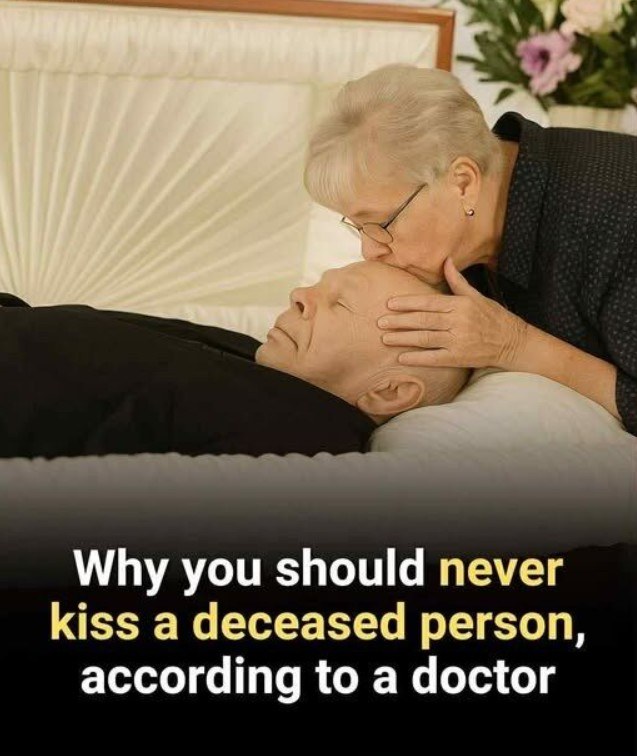Saying goodbye to a loved one after death is one of life’s most profound and emotional experiences. Across cultures and religions, final gestures of affection—such as touching a deceased hand, kissing a forehead, or holding someone close one last time—carry deep symbolic meaning. For many, these moments provide a sense of closure when words are no longer enough. However, medical professionals and public health experts now caution that while these gestures are emotionally powerful, they can also carry health risks that grieving families may not fully realize.
Dr. Viktor Ivanovik, a physician from Moldova known for sharing practical medical advice on social media, recently went viral after explaining why physical contact with the deceased is not always safe. His post generated widespread discussion, as it challenged traditions that have been passed down for generations. “We need to balance emotional needs with the medical realities after death,” Ivanovik said. “In some situations, direct contact can expose people to harmful bacteria or viruses, and families should understand the risks before making that choice.”
While rare, it is possible for infections to be transmitted from a recently deceased body, especially if the cause of death was a contagious disease. Illnesses like tuberculosis, hepatitis, meningitis, or viral hemorrhagic fevers may remain infectious for a time. Even though proper handling quickly reduces the risk, there is still a window during which contact could be dangerous. For instance, open sores or bodily fluids may harbor pathogens, and touching without protection could put mourners at risk.
These warnings are not meant to strip away tradition or discourage expressions of love. Instead, they encourage awareness and caution—particularly during outbreaks or when death is caused by an infectious disease. During the Ebola epidemic, for example, cultural practices involving washing or embracing the deceased inadvertently contributed to the virus’s spread.
For everyday families facing loss, the goal is to find a balance between honoring tradition and staying safe. Funeral directors, medical professionals, and cultural leaders often work together to ensure families can grieve meaningfully without unnecessary risks. This might involve preparing the body to reduce exposure, using gloves if touch is important, or substituting symbolic gestures for physical contact.
There are many safe ways to express love and say goodbye. Placing a flower in the casket, writing a heartfelt letter, lighting a candle, or sitting quietly in reflection can provide closure. Some families wrap a blanket around the deceased, recite prayers, or place a cherished object with them—gestures that carry just as much meaning as physical touch. Dr. Ivanovik emphasizes that “the love behind the gesture matters more than the gesture itself.”
Modern grief counseling supports symbolic rituals as well. What matters most is intention: showing love, acknowledging loss, and finding a personal way to say goodbye. Whether through spoken words, written messages, or small meaningful actions, these rituals help people process grief safely.
Of course, limiting physical contact may feel impossible in cultures where touching the deceased is essential. Ivanovik acknowledges this emotional struggle and encourages informed dialogue rather than strict prohibitions. Families should understand the risks and be guided toward safe practices that respect their traditions.
The guidance also underscores a broader need for public health awareness during grief. Most people focus only on loss and emotion, not on germs or infection. By providing compassionate education, medical staff and funeral professionals can help families make informed decisions without judgment or cultural disruption.
Ultimately, the lesson is that love can be expressed safely. The risk of infection is low but real, and in certain situations—such as outbreaks or infectious deaths—avoiding direct contact may be the wisest choice. Choosing a safer alternative does not diminish one’s love; it protects the living while honoring the deceased.
Dr. Ivanovik’s core message is mindfulness. Grief is universal, as is the need for closure. But closure does not require unnecessary risk. A kiss on the forehead may comfort, but so can a letter filled with unspoken words. A last hand held may feel meaningful, but so can the glow of a candle lit in remembrance.
What matters most is the enduring love that survives death—the bond no illness, warning, or loss can erase. By approaching farewells with care and compassion, families can honor their loved ones in ways that are both safe and deeply meaningful, ensuring that the final goodbye is an expression of love, not a source of risk.
